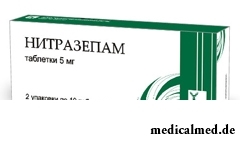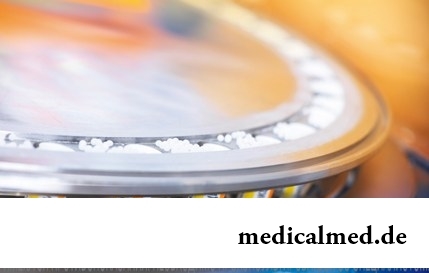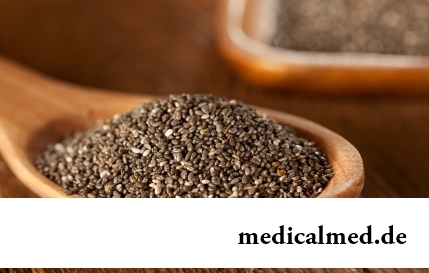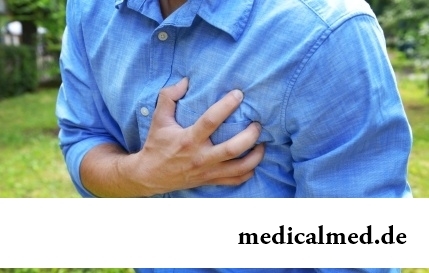





Nitrazepam
Application instruction:
 Nitrazepam – strong somnolent drug from group of benzodiazepines with anxiolytic, anticonvulsant, sedative and miorelaksantny action.
Nitrazepam – strong somnolent drug from group of benzodiazepines with anxiolytic, anticonvulsant, sedative and miorelaksantny action.
Form of release and structure
Dosage form – tablets: ploskotsilindrichesky or spherical shape, color, white with a yellowish-greenish shade, with a facet (on 10 pieces in a blister strip packaging, in a pack of cardboard 1, 2 or 5 packagings; on 20 or 50 pieces in bank polymeric or from light-protective glass, in a pack of cardboard 1 bank).
Active agent: nitrazepam, its contents in 1 tablet makes 5 mg.
Additional components: polyvinylpirrolidone low-molecular medical (povidone), sugar milk (lactose), talc, примогель (sodium carboxymethylstarch), potato starch, magnesium stearate.
Indications to use
- Sleep disorders of various nature of an origin (difficulty with backfilling, frequent night and/or early morning awakenings);
- Noctambulation;
- Some forms of convulsive attacks, including Vest's syndrome (fulminant nodding salaamova of a spasm) at children of younger age;
- Organic lesions of the central nervous system (disturbance of blood circulation of a brain, effect of a craniocereberal injury);
- Neurosises;
- Maniac-depressive psychosis;
- The mental disorders which are followed by increased feeling of concern and alarm;
- Encephalopathy with epileptic manifestations;
- Abstinence syndrome at alcoholism and drug addiction;
- Schizophrenia (as a part of a combination therapy).
Contraindications
Absolute:
- Heavy depression;
- Acute respiratory insufficiency;
- Medicinal or alcohol addiction;
- Drug addiction;
- The acute drunkenness which is followed by weakening of the vital functions;
- Temporal epilepsy;
- Closed-angle glaucoma;
- Coma;
- Shock;
- Myasthenia;
- Hypercapnia;
- Serious chronic obstructive illness of lungs;
- Acute intoxications the medicines having the oppressing effect on the central nervous system;
- Disturbance of swallowing at children;
- Period of pregnancy and lactation;
- Hypersensitivity to components of drug or other benzodiazepines.
Relative:
- Respiratory insufficiency;
- Hyperkinesias;
- Cerebral and spinal ataxy;
- Liver and/or renal failure;
- Organic diseases of a brain;
- Night an apnoea (including assumed);
- Hypoproteinemia;
- Ataxy;
- Psychosis;
- Tendency to abuse of psychoactive medicines;
- Medicinal dependence in the anamnesis;
- Advanced age.
Route of administration and dosage
Nitrazepam should be accepted inside.
As sleeping pill at sleep disorders – 1 time a day in 30 minutes prior to a dream. The recommended doses:
- Children till 1 year – 1,25-2,5 mg;
- Children of 1-5 years – 2,5-5 mg;
- Children of 6-14 years – 5 mg;
- Teenagers are more senior than 14 years and adult – 5-10 mg, the most admissible daily dose – 20 mg;
- Elderly people (65 years are more senior) – 2,5-5 mg.
The recommended doses at use of Nitrazepam as anticonvulsant and anxiolytic drug:
- Adults – on 5-10 mg 2-3 times a day;
- Patients of advanced age – on 2,5-5 mg 2-3 times a day;
- Children of 6-14 years – 7,5-15 mg (daily dose) in 3 receptions;
- Children of 1-6 years – 5-10 mg (daily dose) in 3 receptions;
- Children till 1 year – 2,5-7,5 mg (daily dose) in 3 receptions.
2/3 daily doses are recommended to be accepted for the night.
When calculating a children's dose of nitrazepam it is recommended to consider body weight. For children weighing up to 30 kg appoint 0,3-1 mg/kg/days in 3 receptions.
At Vest's syndrome at children aged from 1 up to 2 years appoint 2,5-5 mg a day in 1 reception.
Chest and to children who cannot swallow a tablet entirely the corresponding amount of drug can be crushed and dissolved (to suspend) in a small amount of water.
Treatment duration usually makes 30-45 days.
All doses stated above are approximate. In each case the doctor defines an optimum dose individually depending on the indication, the general condition of the patient, an etiopathogenesis and individual portability of drug.
Side effects
- Nervous system: in an initiation of treatment (especially at people of advanced age) – decrease in concentration of attention, delay of mental and motor reactions, dizziness, feeling of fatigue, obtusion of emotions, drowsiness, slackness, an ataxy; seldom – confusion of consciousness, euphoria, a katalepsy, a headache, dystonic extrapyramidal reactions (the uncontrollable movements of a body, including an eye), a speech smazannost, a depression, an ecmnesia, a dysarthtia, muscular weakness, a tremor; in some cases – paradoxical reactions (psychomotor excitement, alarm, fear, sleeplessness, aggressive flashes, an acrimony, hallucinations, a muscular spasm, suicide bent);
- Alimentary system: hypersalivation or dryness in a mouth, decrease or increase in appetite, nausea, vomiting, a diarrhea/lock, jaundice, increase in activity of hepatic transaminases and an alkaline phosphatase, abnormal liver function;
- Urinogenital system: incontience or ischuria, increase or decrease libido, renal failure, dysmenorrhea;
- Bodies of a hemopoiesis: anemia, neutropenia, leukopenia, thrombocytopenia, agranulocytosis (unusual fatigue or weakness, pharyngalgia, hyperthermia, fever);
- Cardiovascular system: lowering of arterial pressure; seldom – tachycardia;
- Allergic reactions: an itch, rash on skin;
- Others: accustoming, medicinal dependence; seldom – decrease in body weight, bulimia, a vision disorder (diplopia), oppression of a respiratory center.
At a sharp dose decline or the termination of reception of Nitrazepam development of the withdrawal which is shown the following symptoms is possible: psychomotor initiation, alarm, fear, acrimony, depersonalization, dysphoria, tremor, sleep disorder, headache, disorders of perception (including paresthesia, hyperesthesia, hyperacusia, photophobia), depression, hallucinations, sweating strengthening, tachycardia, nausea, vomiting, spasm of unstriated muscles of internals and skeletal muscles, spasm; seldom – acute psychosis.
At newborns whose mothers during pregnancy accepted Nitrazepam, suppression of a sucking reflex, disturbance of breath and oppression of the central nervous system is possible.
Special instructions
With care it is necessary to begin treatment of patients who before purpose of nitrazepam underwent therapy by any other drug for a long time.
Under special observation during treatment there have to be patients with heavy depressions as they can use drug for implementation of suicide intentions.
Without appointment of the doctor Nitrazepam it is not necessary to accept it is long.
During therapy it is strictly forbidden to take alcohol, it is necessary to refrain from driving of the car and performance of potentially dangerous types of the works demanding the high speed of reactions and special attention.
At prolonged treatment, and also at patients with a renal and/or liver failure it is necessary to control liver enzymes and a picture of peripheral blood.
Nitrazepam has primary potential causing dependence. The risk of formation of medicinal dependence increases at the patients who were earlier abusing medicines or alcohol and also at use of drug in high doses or for a long time, even in usual therapeutic doses. For this reason the doctor appoints this means individually after careful assessment of advantage and possible risk of development of accustoming or dependence.
In order to avoid development of a withdrawal treatment cannot be stopped sharply, it is necessary to reduce a dose gradually.
Drug needs to be cancelled in case of development of paradoxical reactions, such as hallucinations, a superficial dream, the complicated backfilling, psychomotor excitement, strengthening of muscular spasms, fear, aggression, suicide thoughts.
In case of frequent use of drug during pregnancy there is a risk of development of physical dependence (withdrawal) in the newborn.
Reception of Nitrazepam just before childbirth or at the time of delivery can cause in the newborn the weak act of suction ("a syndrome of the sluggish child"), decrease in a muscle tone and arterial pressure, a hypothermia, respiratory depression.
At children of early age the raised products of a phlegm and slime in respiratory tracts therefore it is necessary to take measures for ensuring good passability of respiratory tracts are noted.
Medicinal interaction
Inductors of microsomal enzymes of a liver reduce efficiency of nitrazepam, oral estrogensoderzhashchy contraceptives and Cimetidinum – strengthen and extend.
Mutual strengthening of action is noted at the Nitrazepam combination with psychotropic and anticonvulsants, the general anesthetics, narcotic analgetics, muscle relaxants, lithium drugs, antihistaminic and sedatives, anxiolytics, barbiturates, a clonidine and ethanol.
The accepted at the same time narcotic analgetics increase euphoria and lead to increase of medicinal dependence.
Nitrazepam reduces efficiency of a levodopa, can increase toxicity of a zidovudine.
In case of simultaneous use of clozapine respiratory depression, antihypertensives – the expressed lowering of arterial pressure is possible.
Inhibitors of a microsomal oxidation extend an elimination half-life of nitrazepam and increase risk of development of its toxic effects.
Valproic acid can probably strengthen influence of nitrazepam on the children sick with epilepsy.
Probenetsid and Cimetidinum slow down nitrazepam removal owing to what there is cumulation of substance in an organism that leads to excessive manifestation of sedation.
Rifampicin strengthens nitrazepam excretion.
Terms and storage conditions
To store in the place protected from light and moisture unavailable to children, at a temperature up to 25 ºС.
Period of validity – 3 years.
In Great Britain there is a law according to which the surgeon can refuse to do to the patient operation if he smokes or has excess weight. The person has to refuse addictions, and then, perhaps, he will not need an operative measure.

It is possible to find the extensive range of fruit and vegetables in modern shops. Russians already got used that on counters in any...
Section: Articles about health
The person, as well as all other beings living on our planet feels weather changing. It is the normal meteosensitivity which is not causing to healthy people of special troubles. Meteodependence, on the contrary, is morbid condition, характеризующимс...
Section: Articles about health
The unpleasant feelings connected with spring breakdown are familiar almost to each of us. Often happens that in March-April on the person weakness leans: he suffers from drowsiness, complains of bad mood, loss of interest in life and failures in affairs....
Section: Articles about health
The trophic ulcer is not an independent disease. This heavy complication arising owing to a thermal injury (a burn...
Section: Articles about health
(Xerostomia) many people consider feeling of a xerostomia small and easily removable inconvenience. This delusion: the symptom can demonstrate existence of serious diseases. It is worth to remember also that saliva performs important functions...
Section: Articles about health
Not everyone can brag of the shining Hollywood smile. Even the person who is regularly visiting the stomatologist and watching of oral cavities over health periodically has problems: enamel of teeth darkens under the influence of some products, on it the deposits giving to teeth a grayish or yellowish shade collect....
Section: Articles about health
Within several decades of our compatriots convinced that the use of butter nasty affects on...
Section: Articles about health
Among a set of the perfumery and cosmetic goods which are released today the special group is made by the means containing antibacterial components. Such types of gels, shampoos, soaps, creams, lotions and other products are positioned by manufacturers as a panacea...
Section: Articles about health
For the city dweller the fitness is the most convenient sport. It is enough to acquire the subscription to the gym to get access to various apparatuses and an opportunity to train under the leadership of the experienced consultant. Many consider fitness the best way of maintenance of physical shape and receiving dynamic loads which the people occupied preferential with brainwork so need. Nevertheless, representations of most of consumers of similar services about специф...
Section: Articles about health
Stability of a hormonal background is one of the most important conditions of preservation of health of the woman. At the same time endocrine system –...
Section: Articles about health
The phenomenon of improvement of a condition of the patients at administration of drugs who are not containing active agents, so-called effect of placebo is known long ago. At the end of the 18th century the American doctor Perkins began to treat people the "miracle" sticks made of a spl...
Section: Articles about health
For the help to doctors in the choice of optimal solutions for treatment of various diseases the Cochrane scientific organization (Cochrane) conducts joint researches with representatives of scientific community around the world. The analysis of a series of the conducted researches of the drug Oscillococcinum® relating to group of cold remedies became one of the last methanolyses....
Section: Articles about health
All like to sing. Small children with pleasure are engaged in a vocal, not especially thinking of hit in a melody. Adults most often...
Section: Articles about health
Contrary to popular belief, the multiple sclerosis (MS) is not connected neither with sclerous changes of walls of vessels, nor with age forgetfulness and problems with concentration of attention. This disease has the autoimmune nature. Pathological process of a vyrazh...
Section: Articles about health
About influence of fasting days on an organism it is told much – both about advantages, and about shortcomings. It is considered that fasting day in the form of a short-term monodiet is useful, promoting effective removal of slags from an organism whereas irregular, excessively long, spontaneous fasting days lead only to deterioration in health. How to derive benefit from the sparing diet and not to do much harm to itself? Let's consider the main advantages and shortcomings of fasting days and their influence on an org...
Section: Articles about health
Childbirth is the most important event in life of each woman. We are women we give birth to the new little man on this light. Now...
Section: Articles about health
Hemorrhoids – extremely widespread disease. Periodically arising inflammations and bleeding of hemorrhoidal nodes cause serious discomfort to nearly fifteen percent of adults. Meanwhile, having a clear idea of the aggravation reasons...
Section: Articles about health
The phenomenon of the panic attack is known long ago, but the reasons of its emergence still are up to the end not found out. It is established that more than 30% of people at least once in life become the victims of very unpleasant phenomenon: without everyones on that the reasons they have a feeling of horror which is followed by a cardiopalmus, a shiver and the fever or feeling of sudden heat increased by sweating, breath constraint, dizziness, nausea....
Section: Articles about health
The name of this disease precisely reflects the problem reason: it consists in the bra fastener pressure upon a certain zone...
Section: Articles about health
There is a lot of fans of beer in our country. Statistically, on each average Russian (including women and children) in a year about 60 liters of this drink are consumed. It is not a lot of, as in the Czech Republic or Germany, but figure all the same impressive. Radova...
Section: Articles about health
The mankind knows that some toxins at intake in the minimum quantities have therapeutic effect from an extreme antiquity. Many substances recognized poisonous are applied in the medical purposes also today, being the main operating components of the medicines which are officially produced by pharmaceutical industry. Let's tell only about the most known of them....
Section: Articles about health
About 20% of the population of our planet have a hypertension (permanent increase in arterial pressure). This disease negatively narrations...
Section: Articles about health
The business lady, the become mother, it is necessary to solve an array of problems. But of them is main: how to combine the beloved child and work? What traps trap the working mother and how she needs to behave?...
Section: Slideshow
The chia plant, or the Spanish sage, is from South America. The indigenous people of the continent since ancient times used its seeds in food: small, but very nutritious kernels, in a form the reminding fasolina. Indians knew about useful properties of seeds of a chia, and applied them to maintenance of vitality and increase in endurance before serious exercise stresses....
Section: Articles about health
For the time being the perspective of heart diseases seems to most of people remote and foggy. But sooner or later практичес...
Section: Articles about health
Traveling all over the world, many try to try the most exotic dishes of national cuisines. There is even a so-called gastronomic tourism which, according to gourmets, not only allows to receive new feelings, but also is capable to show life the friend...
Section: Articles about health
Scientists have no unambiguous opinion on a proximate cause of emergence of a carcinoma cutaneum today. Only the factors promoting development of this illness are precisely established. Treat them: long impact on skin of ultraviolet rays, radiation exposure, thermal injuries, injuries of skin by aggressive chemicals (pitches, acids, alkalis, etc.), genetic predisposition (existence of malignant new growths of skin in the family anamnesis), at...
Section: Articles about health
